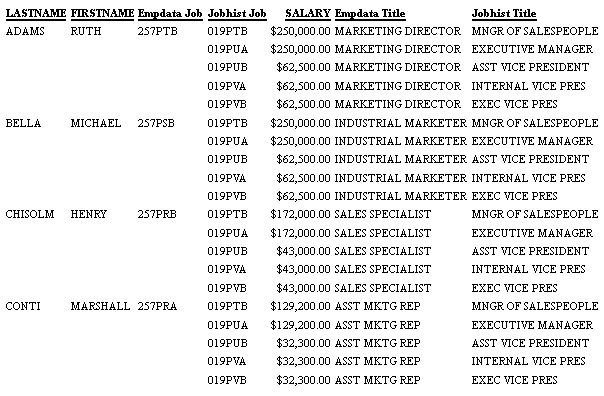Syntax: How to How to Define a Conditional Join in the Master File
The conditions specified in the join are considered virtual fields in the Master File. You can use the CRJOINTYPE attribute to specify the type of join.
FILENAME=filename, SUFFIX=suffix [,$]
SEGNAME=file1, SEGTYPE= {S0|KL} [,CRFILE=crfile1] [,$]
FIELD=name1,...,$
.
.
.
SEGNAME=seg, SEGTYPE=styp, PARENT=parseg,
CRFILE=xmfd, [CRSEG=xseg, ], [CRJOINTYPE = {INNER|LEFT_OUTER}]
JOIN_WHERE=expression; [JOIN_WHERE=expression; ...] ,$where:
- filename
-
Is the name of the Master File.
- suffix
-
Is the SUFFIX value.
- file1
-
Is the SEGNAME value for the parent segment.
- name
-
Is any field name.
- seg
-
Is the segment name for the joined segment. Only this segment participates in the join, even if the cross-referenced Master File describes multiple segments.
- styp
-
Is the segment type for the joined segment. Can be DKU, DKM, KU, or KM, as with traditional cross-references in the Master File.
Note: If you specify a unique join when the relationship between the host and cross-referenced files is one-to-many, the results will be unpredictable.
- parseg
-
Is the parent segment name.
- xmfd
-
Is the cross-referenced Master File.
- xseg
-
Is the cross-referenced segment, if seg is not the same name as the SEGNAME in the cross-referenced Master File.
- expression
-
Is any expression valid in a DEFINE FILE command. All of the fields referenced in all of the expressions must lie on a single path.
Example: Using a Conditional Join in the Master File
The following Master File named EMPDATAJ1 defines a conditional join between the EMPDATA and JOBHIST data sources.
FILENAME=EMPDATA, SUFFIX=FOC , DATASET=ibisamp/empdata.foc SEGNAME=EMPDATA, SEGTYPE=S1 FIELDNAME=PIN, ALIAS=ID, FORMAT=A9, INDEX=I, $ FIELDNAME=LASTNAME, ALIAS=LN, FORMAT=A15, $ FIELDNAME=FIRSTNAME, ALIAS=FN, FORMAT=A10, $ FIELDNAME=MIDINITIAL, ALIAS=MI, FORMAT=A1, $ FIELDNAME=DIV, ALIAS=CDIV, FORMAT=A4, $ FIELDNAME=DEPT, ALIAS=CDEPT, FORMAT=A20, $ FIELDNAME=JOBCLASS, ALIAS=CJCLAS, FORMAT=A8, $ FIELDNAME=TITLE, ALIAS=CFUNC, FORMAT=A20, $ FIELDNAME=SALARY, ALIAS=CSAL, FORMAT=D12.2M, $ FIELDNAME=HIREDATE, ALIAS=HDAT, FORMAT=YMD, $ SEGNAME=JOBHIST, PARENT=EMPDATA, SEGTYPE=DKM, CRFILE=ibisamp/jobhist, CRJOINTYPE=INNER,$ JOIN_WHERE = EMPDATA.JOBCLASS CONTAINS '257' AND JOBHIST.JOBCLASS CONTAINS '019';$
The following request uses the joined Master File.
TABLE FILE EMPDATAJ1
SUM SALARY TITLE AS 'Empdata Title' FUNCTITLE AS 'Jobhist Title'
BY LASTNAME
BY FIRSTNAME
BY EMPDATA.JOBCLASS AS 'Empdata Job'
BY JOBHIST.JOBCLASS AS 'Jobhist Job'
WHERE LASTNAME LT 'D'
ON TABLE SET PAGE NOPAGE
ON TABLE SET STYLE *
GRID=OFF,$
FONT=ARIAL, SIZE=8,$
TYPE=TITLE, STYLE=BOLD,$
ENDThe following image shows that all of the job class values from the EMPDATA segment start with the characters 257, and all of the job class values from the JOBHIST segment start with the characters 019, as specified in the join condition:
